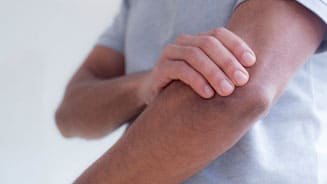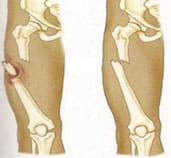Left arm Pain
10
July
2021

What is Left arm Pain?
Left arm Pain can develop for a variety of reasons, some more serious than others. And even though it’s tempting to try at-home remedies to relieve the pain quickly, it’s recommended to visit a dentist as soon as possible to make sure the source of the pain is not an inflammation or a disease.
The most common thought that comes with experiencing arm pain is the assumption that you have injured your arm. However, that pain can actually derive from elsewhere in the body, and the arm pain can be a symptom of something more serious. Before jumping to any conclusions, pain in your arm, even the left one, is normal and can occur in anyone of any age. The cause of that pain can be due to a number of reasons, all listed below, and the relative treatment is then given.
Why is left arm pain so special?
The causes of arm pain are many and are divided into three categories. We have the “basic” arm pain that can be experienced in any part of the body, then we have injuries that are specific to the left arm, and then the skeletomuscular injuries which can be defined by injuries relating to bones and muscles.
To begin with the most basic injuries, we have:
Fractured or broken bone: If an intense and acute pain is felt immediately following an injury, or if any slight movement of the affected limb causes sharp pain along with its swelling and the feeling of being numb, it is likely that the bone has been cracked or broken. In rare and special cases, an audible sound may indicate that a bone has been shattered. Either way, if one suspects that their arm has been broken or fractured, getting a quick medical and professional checkup is the best course of action.
Sprain and strains: A sprain is defined as the ripping or overstretching of one or more ligaments or tendons, while a strain, is the ripping or overstretching of a muscle. Sprains are a pretty common injury among sportsmen and even very active people. In most circumstances, they can be treated at home, but if the sprain is severe, surgery to repair the ligament or tendon is required. Similarly, strains may be generated by a single occurrence or by the repetition of a movement that puts pressure on the muscle.

Anxiety: A reason for left arm pain that most people would not expect is anxiety. It can lead to physical discomfort or may exacerbate discomfort in the left arm which may be caused by another condition. The way it works is that in some cases, anxiety will make sensitive and seemingly little pain feel bigger than it is, due to the fact that the cause of the pain is unknown. This anxiety might become increasingly unpleasant if there is a fear that the pain is a symptom of a major problem, making the pain in the affected limb feel greater.
As previously mentioned, there are some caused that are specific to the left arm. These causes include:
Angina: The basis of Angina is the lack of oxygen that travels to the heart. The results of the heart not getting the levels of oxygen it needs is the feeling of pain in the left arm. Some other symptoms may be pain in the left shoulder or the left side of the neck and back. The reason why Angina arm pain is specific to the left side is because of the position of the heart itself. Angina is divided into two types: the stable angina which is manageable and predictable and the unstable angina which is more serious and is experienced when someone’s heart is experiencing a constant lack of oxygen. The latter type is the major red flag that a person should look out for, and should visit a doctor as soon as they have experienced it. While it is not an indication of a heart attack, it is an indication of coronary heart disease
Heart attack: Heart attacks occur when an area of the heart muscle is damaged or stops functioning all together. This lack of performance can be due to the absence of oxygen or the rupture of a coronary artery that halts the blood flow to an explicit area of the heart. According to the American Heart Association, “One of the most common symptoms of a heart attack is left arm pain”, which is explained by the fact that the nerves that come from the heart and those coming from the arm project signals to the same brain cell. This causes a confusion in the particular brain cell that cannot isolate the source of the pain. This confusion results in the pain in the left arm specifically.

Pinched nerve: Pinched nerve, also known as cervical radiculopathy, is defined in simpler terms as a compressed or irritated nerve. One of the major causes for a pinched nerve is a herniated disk caused by trauma or a wear-and-tear injury. Pinched nerve symptoms are comparable to those of a herniated disk: Numbness, tingling, or a burning sensation in your arm are just a few of them. Any movement at all, may increase the level of pain.
Vascular thoracic outlet syndrome: This syndrome is characterized by the compression of blood arteries under the collarbone, usually as a result of trauma, and can lead to progressive nerve damage if left untreated.
-
Tendonitis: Tendon injuries are different from other types of injuries since they consequentially affect the movement of the affected limb and do not affect the bone or muscle itself. Tendonitis, which can affect your wrist, elbow, or shoulders, is an inflammation of the tendons in any of the areas mentioned above. It can be minor or severe, and causes throbbing discomfort in the injured area, which is easily treatable with rest and over-the-counter medications.
Skeletomuscular injury: In the case where the left arm pain is not due to heart issues it might be due to an issue with muscles or bones. These include:
Bursitis: This injury is defined as the inflammation of the Bursa. The Bursa is a fluid filled sac that appears in the body and causes friction at a joint. Bursitis is classified as a skeletomuscular injury since the bursa sac acts like a cushion squeezed between the bone and its surrounding tissue affecting the skeleton. The most common symptom of Bursitis is left arm or shoulder pain.

Rotator cuff tear: This group of muscle and cluster of tendons are what hold the shoulder in its socket and aid in the rotation of the arm as well as the ability to lift and lower the arm. This injury affects one's shoulder and worsens as one gets older. It is defined as a tear or break in the tendons of one's shoulder. Rotator cuff injuries are most frequent in athletes or those who work in industries that require a lot of repetitive overhead motions. They have a big impact on your ability to use and rotate your shoulder, and they require physical therapy to recover.
Herniated disk: The spine’s ability to move, bend, and even flex is due to disks found all along the spine. These disks are “little cushions” found in between each of the spine’s rigid bones, also known as vertebras. When one of these disks slips out of place, it affects the surrounding nerves, causing agonizing pain, weakness, numbness, and tingling in places like the arm and neck. It is important to note that symptoms of a herniated disk are arm pain, numbness and/ or weakness; all of them being symptoms that might resemble those of a heart attack. However, the cause is difference, so no need to be alarmed. The most common cause for a disk herniation is the repetition of lifting motion, as well as lifting heavy.
In order to identify the fact that the pain is not actually due to heart problems, one may experience the following characteristics:
The pain only lasts for a few seconds at a time
The pain characteristic is stabbing
The pain is localized and is only experienced in a small area of the arm
That discomfort is the only symptom that has occurred, and it occurs for a couple of days
Experiencing these characteristics are what prove to one that their pain is skeletomuscular
When to see a doctor?
While it seems like it is a given, emergency treatment should be one’s first option in the cause when the pain in the left arm is:
Sudden
Severe
Accompanied by pressure or squeezing in the chest
Now that the emergency information is laid out on the table, here are some factors which will distinguish the “I can take care of myself” kind of pain and the “this is very serious and should be treated professionally” pain:
Feeling of sharp pain during movement which is relived at rest
Feeling of severe pain
Obvious swelling
Increase in redness and discomfort in the affected area
In the case of a sudden injury
In the case of an injury being accompanied by a snapping sound
In the case where normal movement is harder than usual
In the case where turning the palm from down to up and vice- versa is difficult
In the case where the pain hasn’t been alleviated after a long period of rest, elevation, and ice
In the case where one’s anxiety episodes are followed by pain in the left arm
What to expect at the doctor’s office?
If you are experiencing any of the symptoms mentioned above, then seek medical care without even thinking twice. As previously mentioned, since left arm pain is a big sign of a possible heart attack, a number of tests will be run to ensure that one is or isn’t experiencing a heart attack. To alleviate your worries, here are the possible tests that might be run at the doctor’s office:
An EKG to monitor one’s is a primary step the medical personal will take.
If necessary, a line will be put in the vein of your arm to ensure that the patient is receiving enough fluids and medication.
In order to make sure that nothing else is affected, X-rays, MRI’s and CT scans will be done.
Treatments
Treatments will depend on severity of the arm pain as well as the cause of the arm pain. In the case where one has broken bones a surgery along with a cast for several weeks will be necessary to put back the broken limbs into position and keep them immobilized until they completely heal.
In the case of sprains and strains, a splinter to immobilize the limb will be subscribed with mandatory rest and icing treatments.
In the case where one has been diagnosed with a heart disease, the treatment will most likely include medicine along with lifestyle change, and in the worst cases a surgery to clear or bypass blocked arteries.
In the case of the Skeletomuscular injury mentioned above, Physical therapy rest, and pain / anti-inflammatory medication are the main treatments.
Pain in the left arm is an occasional scenario that comes with age, activity levels and anxiety levels, so when self-diagnosing, jumping to the conclusion of a heart attack is not the best option. Getting oneself checked for the possibility of heart diseases is crucial and will ease the constant worrying. However, it is important to not think of the worst and get tested professionally before making any unnecessary assumptions.
References:
(Ann Pietrangelo, Apr 24, 2019) “Why Is There Pain in My Left Arm.?” Health writer.
Derived from:
https://www.healthline.com/health/pain-in-left-arm
(Scott Frothingham, Mar 7, 2019) “Left Arm pain and anxiety.” Healthline copywriter.
Derived from:
https://www.healthline.com/health/left-arm-pain-anxiety
(Alyse Wexle, Jul 3, 2019) “Why do I have a pain in my left arm?” Science writer.
Derived from:
https://www.medicalnewstoday.com/articles/317652
If you or anyone you know is suffering from pain, call us today on (469) 562 4188 to book an appointment with our expert doctors.